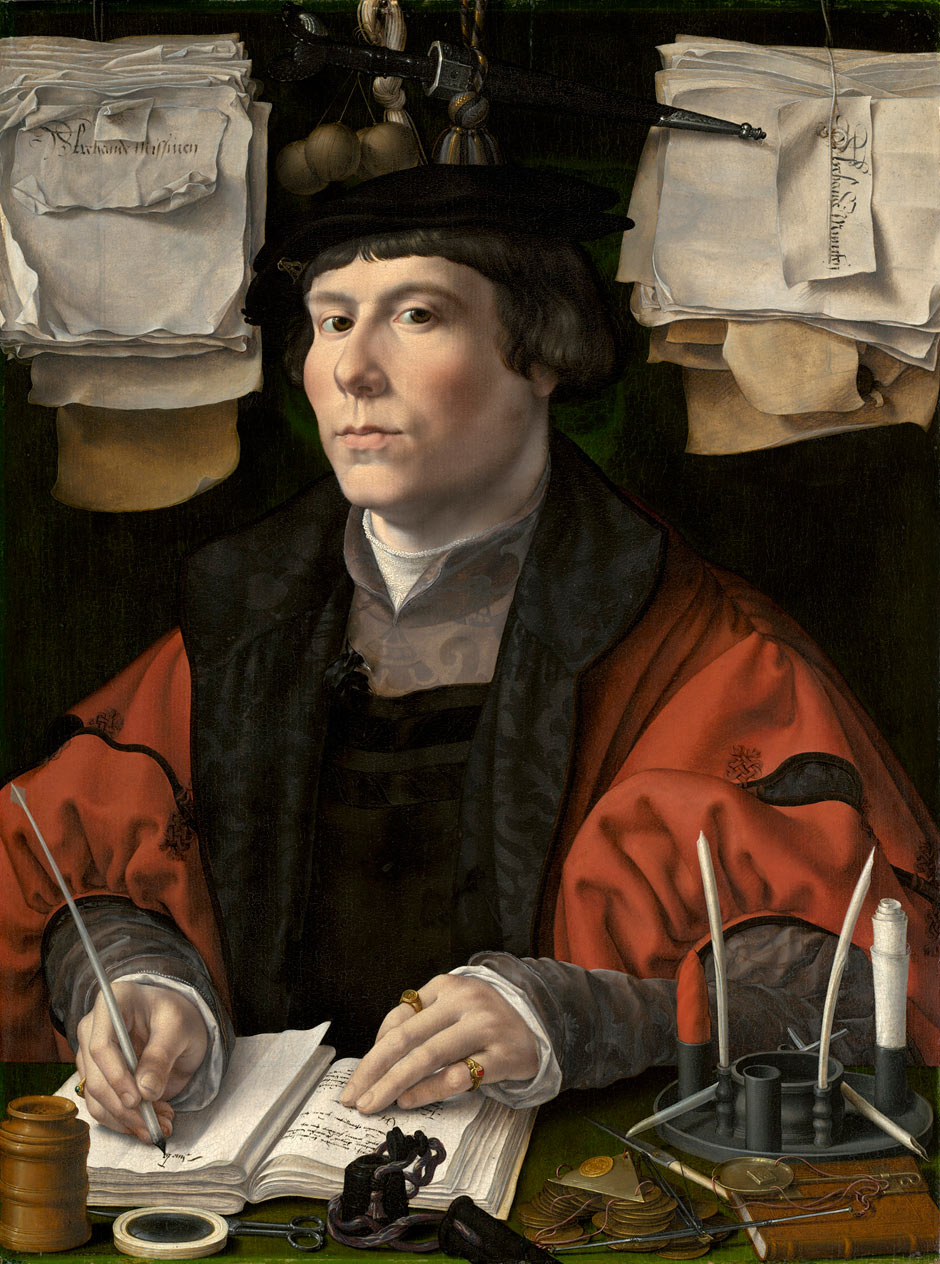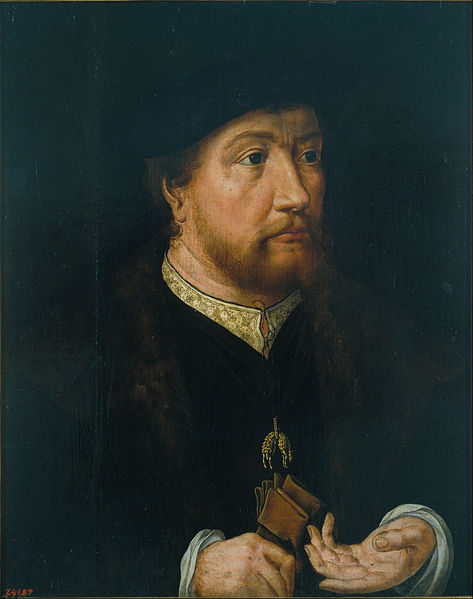Jan Gossaert (active 1503; died 1532) was one of the most startling and versatile artists of the Northern Renaissance. A pivotal Old Master, Gossaert changed the course of Flemish art, going beyond the tradition of Jan van Eyck and charting new territory that eventually led to the great age of Rubens – yet this is the first major exhibition dedicated to him in more than 45 years.
'Jan Gossaert’s Renaissance' at the National Gallery, London, 23 February – 30 May 2011 included more than 80 works, and placed Gossaert in the context of the art and artists that influenced his development. It brought together many of the artist’s most important paintings

('Virgin and Child', about 1527, Museo Nacional del Prado, Madrid;
'Hercules and Deianeira', 1517, Barber Institute of Fine Arts, Birmingham;

and 'Saint Luke Painting the Virgin', 1520–22, Kunsthistorisches Museum, Vienna)
with drawings, prints and contemporaneous sculptures.
Gossaert made his name working for wealthy and extravagant members of the Burgundian court in the Low Countries. In 1508–9, as part of a Vatican embassy, he was the first Northern artist to travel to Rome to make copies after antique sculpture. He became the first artist to introduce the Italian Renaissance style of depicting historical and mythological subjects with sensuous nude figures into the art of the Low Countries.
The National Gallery has one of the largest and finest collections of Gossaert's paintings in the world – a highlight being

'The Adoration of the Kings' (1510–15).
This landmark exhibition allowed them to be set in the context of the full range of the artist’s work, from the fruits of his early visit to Rome to the unusually erotic presentation of the nude in his Adam and Eve series.
'Jan Gossaert’s Renaissance' was displayed across six rooms and traced the key themes of the artist’s work. Renaissance sculpture, prints and drawings by contemporaries such as Albrecht Dürer, Jacopo de’Barbari and Lucas van Leyden are included to demonstrate the artistic milieu of which he was a part.
The story of Adam and Eve fascinated Gossaert, and he would return to this theme numerous times over the span of his 30-year career. Room 2 of the exhibition demonstrated how he explored the erotic nature of the relationship between the first couple in some exceptional – almost unprecedented – paintings and drawings. The earliest example in Gossaert’s oeuvre,

'Adam and Eve' (about 1510, Museo Thyssen-Bornemisza, Madrid)
and the peerless
'Adam and Eve' (about 1520, Royal Collection)
were displayed alongside some of his preparatory drawings as well as

Dürer’s famous 1504 engraving of 'Adam and Eve' (British Museum, London).
Although Gossaert’s early 'Adam and Eve' was initially based on this famous, imaginative work, his erotic and psychological interpretations diverged greatly from Dürer’s interest in the perfect human form, as he explored the bold sensuality of the two figures.
This room also examined Gossaert’s interest in the Gothic tradition, the new Renaissance and architectural motifs. The 'Adoration of the Kings' was shown alongside prints that provided source material for the parts of the composition, enabling visitors to further explore this sumptuous altarpiece.
Another highlight of the exhibition was the reuniting of a triptych for the first time since it was painted in the early 16th century – with centre panel

'Agony in the Garden of Gethsemane' (1509–10, Gemäldegalerie, Berlin),
and its exterior wings

'Saint Jerome Penitent' (both panels framed together, National Gallery of Art, Washington).
Gossaert’s masterpiece

'Agony in the Garden of Gethsemane'
is one of the most carefully observed and naturalistic night scenes painted at that time. With its backlit angel, beneath a sliver of silvery moon and an unusual youthful Christ kneeling in prayer, this impressive painting combines an extraordinarily realistic effect of the moon and unusual lighting effects with a powerfully atmospheric depiction of the biblical scene.
Some of Jan Gossaert’s most compelling paintings depict sensuous, mythological nudes that can be understood as a celebration of corporeal pleasures. Reviving classical eroticism, their idealised forms are voluptuous and seductive yet also sculptural, painted to evoke the sheen of marble. Long time patron Philip of Burgundy – who was a churchman as well as Admiral of the Netherlands – commissioned mythological paintings such as

'Salmacis and Hermaphrodite' (about 1517, Museum Boijmans Van Beuningen, Rotterdam)

and 'Venus' (about 1521, Pinacoteca dell’Accademia dei Concordi, Rovigo)
not only for his own collection but also to give as gifts. Paintings, prints and drawings that demonstrate Gossaert’s portrayal of the nude and his adaption of the eroticism of the past were displayed in Room 3.
In a series of paintings of the Virgin and Child, Gossaert explored the natural, lifelike relationship of mother and child – a motif that was introduced to painting of the Low Countries in the early 1520s. Taking inspiration from Italian Renaissance examples, Gossaert created new compositions and poses of figures, but also focused on the motif of the child at play. Featured works included '

Virgin and Child' (about 1527, Museo Nacional del Prado, Madrid),
in which Gossart emphasised the sensuous nature of the intimate embrace of the figures,
and the exquisite and fine

'Virgin and Child' (about 1525, The Art Institute of Chicago, Illinois).
Here, the sculptural forms of the Virgin and Child surrounded by the brilliance of the sun’s rays virtually burst out of the frame.
The final – and largest – room of 'Jan Gossaert’s Renaissance' was devoted to portraits and will showcase his remarkable ability to represent the lifelike appearance of individuals. His close study of physiognomy and extraordinary handling and execution of paint set him apart from his contemporaries in this genre. A highlight was one of the masterpieces of early Netherlandish portraiture:

'An Elderly Couple' (about 1520, The National Gallery, London).
This room also featured many stunning illusionistic portraits in which Gossaert plays intriguing spatial games, creating figures that seem to emerge from the confines of their frames: from the meticulous

'Portrait of a Merchant' (about 1530, National Gallery of Art, Washington),
a tour-de-force of detail in its accessories and documents, to

'Portrait of Anna van Bergen' (about 1526–30, Sterling and Francine Clark Art Institute, Massachusetts),
one of the rare surviving independent portraits of female sitters by Gossaert.
His

'Portrait of Henry III of Nassau' (about 1520–25, Kimbell Art Museum, Fort Worth, Texas)
highlights even further the trompe l'œil effect as the figure seems to step out from the frame to meet the viewer, an illusionistic device of which Gossaert was fond.
Jan Gossaert’s Renaissance celebrated Gossaert’s decisive role as an artistic pioneer, bridging the gap between the Northern and Southern Renaissances and paving the way for Low Country artists of the future.
'Jan Gossaert’s Renaissance' was organised by the Metropolitan Museum of Art, New York (on display there from 6 October 2010 to 17 January 2011) and the National Gallery, London. The exhibition at the National Gallery was curated by Dr Susan Foister, Deputy Director and Director of Collections at the National Gallery.
Publication

'Van Eyck to Gossaert: Towards a Northern Renaissance'
By Susan Frances Jones
Published alongside the exhibition Jan Gossaert’s Renaissance, this book draws on the National Gallery’s collection, and provides an essay and commentaries on 50 selected works – all magnificently illustrated in colour. The author explores one of the most glorious and innovative periods for Netherlandish painting, beginning in the early 15th century with Jan van Eyck, and ending in the late 16th century with Pieter Bruegel.
Susan Frances Jones was Assistant Curator at the National Gallery, London, from 1994 to 1996 and Old Master Society Fellow in the Department of European Painting at The Art Institute of Chicago from 1998 to 2001.
ISBN: 978 1 85709 505 03
More images here, and here and here.
Reviews here and here.












